Hello, Internet.
So, you remember last week’s Crucible-related blog post?
This is another one of those. Today I’ve chosen the prompt “Read “How to Spot a Witch”. Write a paper or create something similar to this essay on how to spot a _________. You fill in the blank: example: How to Spot a Liar. How to Spot a Surfer. Etc. ”.
I knew from the beginning of this assignment that this was a prompt I was interested in completing, but it took me a while to come up with an idea for what I wanted to write about how to spot. I knew I wanted it to be something integral to my own life– something that was a part of my own identity.
The thing I eventually decided to write about was How to Spot a Canadian.
Now, you hear a lot of stereotypes about what Canadians are like, and as a real live Canadian citizen I am here to tell you that almost all of them are, at least in my neck of the woods, pretty much 100% accurate. So, without further ado, here is how to spot a Canadian (with evidence from my own experiences).
#1: Check what they’re wearing. This one is pretty straightforward, so I won’t spend too much time on it. Canadians are known for wearing three things in particular: toques, flannels, and double denim (or, as it’s been dubbed, the Canadian Tuxedo).
Now, I’ve always figured the reasoning behind Canadians wearing toques is pretty obvious– it’s cold here –and I associate flannels largely with the iconography of lumberjacks, which were a big part of Canada’s early history, but I had to do a little bit of research to find out what was so Canadian about double denim.
As it turns out, it’s an interesting story, and it centres around a non-Canadian: Bing Crosby. Way back in the 1950s, Bing Crosby attempted to stay in a hotel in Vancouver. However, they denied him a room. The reason why? He was wearing denim, specifically, a pair of Levi’s jeans, which didn’t meet the hotel dress code. When Levi’s heard about the incident, they decided to create something that would meet the dress code: a tuxedo made out of denim, or a “Canadian Tuxedo”.
As a Canadian, I have of course repped various Canadian looks, although flannels are my favourite.
#2: Find our their favourite coffee chain. Whenever I travel to the states and end up telling someone I’m Canadian, no matter the context, I almost always end up getting asked one question: do you miss Tim Hortons?
As much as a small piece of my soul dies every time I hear this joke, I am a fan of Tim Hortons. I would happily eat Timbits for every meal, not to mention I’m pretty much dependent on coffee to make me a (soft of) functional human being, and Tim Hortons can provide a solid cup of joe.
Tim Hortons is, of course, a piece of Canadian iconography all on its own, but it also ties into another very Canadian thing: hockey. See, Tim Horton (or Miles, as he was actually named), the founder of Tim Horton’s, was a hockey player. Not just any hockey player, either– he was actually considered one of the 100 greatest NHL players in history. He played for twenty four seasons, and might have played more if he wasn’t killed in a car chase at the age of 44.
#3: Find out their favourite sport. To continue from above, another thing Canada is well known for is hockey. While our national sport is actually lacrosse, hockey (or specifically ice hockey) is sort of the unofficial national sport of Canada. Hockey was invented in Windsor, Nova Scotia, and has since become a beloved part of Canada’s culture.
I play hockey, and have from the age of seven, although I have fond memories of playing family hockey games from an even earlier age. If you’ve read about my love of potatoes, you may also know that I spent a lot of time as a child hanging out in hockey rinks while my family members played hockey– one of my sisters and both of my parents are hockey players, and my mum actually played her first hockey game the day I turned one.
I love playing hockey, and consider myself incredibly lucky that I have the opportunity to play. This week, I get to play hockey seven times, and I can think of no more enjoyable way to spend my time.
However, a lot of people prefer not playing hockey but instead watching it, whether on TV or live in a stadium. In elementary school, we were regularly bribed to read more books with the lure of tickets to see the next Giants game. It’s not uncommon to see people wearing jerseys bearing the name and number of their favourite hockey player. In 2011, Vancouverites started riots, which did 5 million dollars worth of property damage, following the defeat of our hockey team, the Canucks, in the Stanley Cup– one example of various similar incidents across Canada.
One person who perhaps should have gotten a nod in the Canadian fashion section is Don Cherry, longtime announcer for Hockey Night in Canada, and the owner of many a unique and eye catching suit.
#4: Listen for Canadian vocabulary when they speak. Canadians are known for using a couple of specific words: “sorry” and “eh”.
I say sorry a lot– in fact, I almost didn’t register that this comic was making fun of Canadians until the punchline, considering that this is an interaction I could reasonably have (probably in a Tim Hortons).
That being said, I don’t apologize quite as much as the folks over in Toronto, where they actually had to pass a law to protect people who say sorry too much. This law, called the Apology Act, essentially states that saying sorry isn’t a direct admission of guilt, the way it might be considered in a court of law other places, because people in Canada frequently apologize for things that were not actually their fault.
There’s also, interestingly enough, a song called Sorry by Canadian singer Justin Bieber.
As for the word “eh”, it tends to be true of less Canadians than the whole overapologizing thing, and you mostly hear it used ironically to make fun of Canadian stereotypes. However, I personally use it unironically, albeit somewhat infrequently, and I do hear it used by other people, so the Canadians-saying-eh stereotype might not be completely untrue.
#5: Offer them maple syrup. Earlier this year, we went on a class trip to California. While there, we worked with buddies from a school called High Tech High. We were encouraged to bring a small gift of some kind for our buddies– I brought a coffee crisp, a chocolate bar available in Canada but not in the United States.
When I gave this gift to my California buddy, he politely thanked me, and then said, “I got you something, too,” before proceeding to pull an entire jug of maple syrup out of his backpack and handing it to me. I didn’t actually get to keep the maple syrup, seeing as it’s ridiculously expensive, but it was an interesting nod to just how much much maple syrup is associated with Canada.
Maple trees are actually such an important part of Canada’s iconography that our flag features a maple leaf. We also have a hockey team called the Maple Leafs. Even our pennies, back when we had them, featured maple leaves.
The most important part of the maple tree, however, is not the leaves. It’s actually the sap, which is what’s used to make maple syrup.
Back in 2011, and ongoing through part of 2012, a heist took place in Quebec. This heist lasted months, and involved the theft of the equivalent of almost 9 million dollars, a value higher than that of any other Canadian heist.
The thing that was being stolen, as you’ve probably guessed by now, was maple syrup.
There’s a Canadian tradition of pouring strips of maple syrup onto snow and letting it freeze into a semi-hard candy, known as snow candy, which is then eaten on a stick. This can be a difficult thing to eat, seeing as despite being frozen, the candy is still incredibly sticky and wont to get stuck in the hair of the person eating it.
Even our money smells like maple syrup. We also have maple flavoured bacon, and maple bacon doughnuts, which are perhaps the epitome of stereotypical Canadian food. In general, we have a larger supply of maple syrup than anyone could ever need.
#6: Try one of these miscellaneous ways to spot a Canadian.
Attempt to pay them in Canadian tire money.
Find out if they, much like my grandpa, ever attempted to keep a pet moose during their childhood.
Start singing this song and see if they know the lyrics.
Ask them about their country’s economy and see if they burst into tears.
Offer them poutine.
In order to supplement my understanding of Canadian stereotypes and how they apply to real people living in Canada, I asked three Canadians some questions.
This has been a lengthy blog post, eh? I’m sorry about that.
Toodles.










